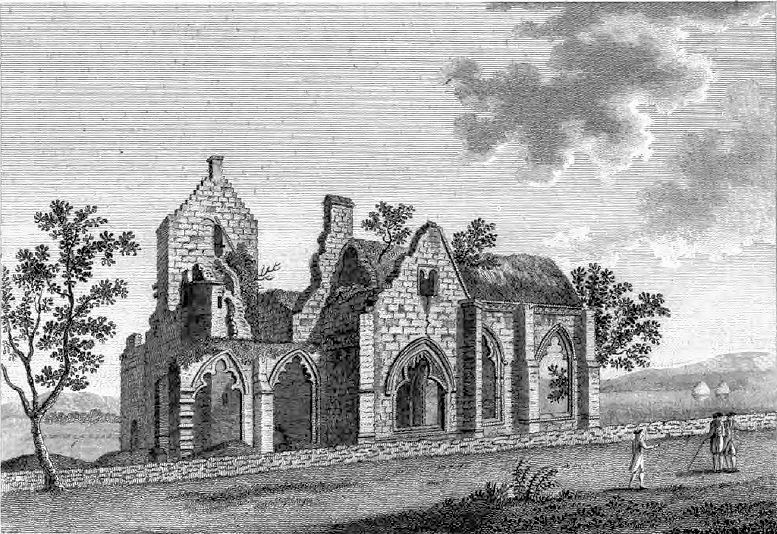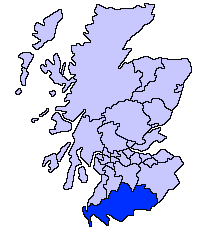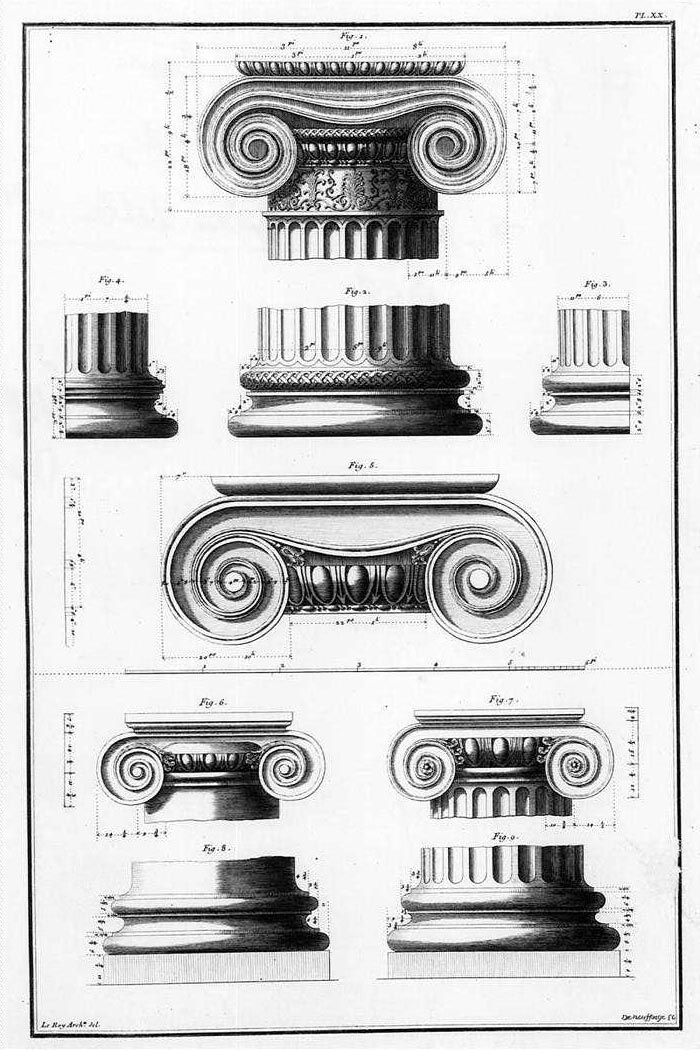|
Midsteeple, Dumfries
The Midsteeple is a municipal building in the High Street in Dumfries, Dumfries and Galloway, Scotland. The structure, which is used as a ticket office and a meeting place, is a Category A listed building. History The first municipal building in the town was a tolbooth on the east side of the High Street which dated back to the 15th century. It had vaulted cellars in the basement, shops on the ground floor and an assembly hall together with a lock-up on the first floor. After securing a share of the Scottish customs and excise duties in 1697, burgh leaders decided to apply this sum to erecting a new townhouse. The foundation stone for the new building, known as the Midsteeple, was laid on 30 May 1705. It was designed by Tobias Bachop of Alloa, based on an outline plan by John Moffat of Liverpool, built in ashlar stone and was completed in 1707. The design involved an asymmetrical main frontage with two bays facing down the High Street; there was an external staircase leading ... [...More Info...] [...Related Items...] OR: [Wikipedia] [Google] [Baidu] |
Dumfries
Dumfries ( ; sco, Dumfries; from gd, Dùn Phris ) is a market town and former royal burgh within the Dumfries and Galloway council area of Scotland. It is located near the mouth of the River Nith into the Solway Firth about by road from the Anglo-Scottish border and just away from Cumbria by air. Dumfries is the county town of the historic county of Dumfriesshire. Before becoming King of Scots, Robert the Bruce killed his rival the Red Comyn at Greyfriars Kirk in the town on 10 February 1306. The Young Pretender had his headquarters here during a 3-day sojourn in Dumfries towards the end of 1745. During the Second World War, the bulk of the Norwegian Army during their years in exile in Britain consisted of a brigade in Dumfries. Dumfries is nicknamed ''Queen of the South''. This is also the name of the town's professional football club. People from Dumfries are known colloquially in Scots language as ''Doonhamers''. Toponymy There are a number of theories ... [...More Info...] [...Related Items...] OR: [Wikipedia] [Google] [Baidu] |
Cupola
In architecture, a cupola () is a relatively small, most often dome-like, tall structure on top of a building. Often used to provide a lookout or to admit light and air, it usually crowns a larger roof or dome. The word derives, via Italian, from lower Latin ''cupula'' (classical Latin ''cupella''), (Latin ''cupa''), indicating a vault resembling an upside-down cup. Background The cupola evolved during the Renaissance from the older oculus. Being weatherproof, the cupola was better suited to the wetter climates of northern Europe. The chhatri, seen in Indian architecture, fits the definition of a cupola when it is used atop a larger structure. Cupolas often serve as a belfry, belvedere, or roof lantern above a main roof. In other cases they may crown a spire, tower, or turret. Barns often have cupolas for ventilation. Cupolas can also appear as small buildings in their own right. The square, dome-like segment of a North American railroad train caboose that contains ... [...More Info...] [...Related Items...] OR: [Wikipedia] [Google] [Baidu] |
Government Buildings Completed In 1707
A government is the system or group of people governing an organized community, generally a state. In the case of its broad associative definition, government normally consists of legislature, executive, and judiciary. Government is a means by which organizational policies are enforced, as well as a mechanism for determining policy. In many countries, the government has a kind of constitution, a statement of its governing principles and philosophy. While all types of organizations have governance, the term ''government'' is often used more specifically to refer to the approximately 200 independent national governments and subsidiary organizations. The major types of political systems in the modern era are democracies, monarchies, and authoritarian and totalitarian regimes. Historically prevalent forms of government include monarchy, aristocracy, timocracy, oligarchy, democracy, theocracy, and tyranny. These forms are not always mutually exclusive, and mixed governm ... [...More Info...] [...Related Items...] OR: [Wikipedia] [Google] [Baidu] |
List Of Category A Listed Buildings In Dumfries And Galloway
This is a list of Category A listed buildings in Dumfries and Galloway, Scotland. In Scotland, the term listed building refers to a building or other structure officially designated as being of "special architectural or historic interest". Category A structures are those considered to be "buildings of national or international importance, either architectural or historic, or fine little-altered examples of some particular period, style or building type." Listing was begun by a provision in the Town and Country Planning (Scotland) Act 1947, and the current legislative basis for listing is the Planning (Listed Buildings and Conservation Areas) (Scotland) Act 1997. The authority for listing rests with Historic Scotland, an executive agency of the Scottish Government, which inherited this role from the Scottish Development Department in 1991. Once listed, severe restrictions are imposed on the modifications allowed to a building's structure or its fittings. Listed building cons ... [...More Info...] [...Related Items...] OR: [Wikipedia] [Google] [Baidu] |
List Of Listed Buildings In Dumfries
This is a list of listed buildings in the parish of Dumfries in Dumfries and Galloway, Scotland Scotland (, ) is a country that is part of the United Kingdom. Covering the northern third of the island of Great Britain, mainland Scotland has a border with England to the southeast and is otherwise surrounded by the Atlantic Ocean to th .... List Key Notes References * All entries, addresses and coordinates are based on data froHistoric Scotland This data falls under thOpen Government Licence {{DEFAULTSORT:List of listed buildings in Dumfries Dumfries ... [...More Info...] [...Related Items...] OR: [Wikipedia] [Google] [Baidu] |
Tom Arthur (Scottish Politician)
Thomas 'Tom' Compton Arthur MSP (born 1985) is a Scottish National Party (SNP) politician. He is the Member of the Scottish Parliament (MSP) for the constituency of Renfrewshire South, having been first elected in 2016 and re-elected in 2021. In May 2021 he was appointed Minister for Public Finance, Planning and Community Wealth in the Scottish Government. Background Arthur was born in 1985 in Paisley, Renfrewshire and raised in Barrhead, East Renfrewshire, where he was educated at Cross Arthurlie Primary and Barrhead High School. He graduated with a Bachelor of Music then later Master of Music from the University of Glasgow. Before entering politics, he worked as a company director, freelance piano teacher and keyboardist. Political career Arthur joined the Scottish National Party in 2009. He was elected as the first SNP Member of the Scottish Parliament (MSP) for the Renfrewshire South constituency at the 2016 Scottish Parliament election. Arthur made his debut speec ... [...More Info...] [...Related Items...] OR: [Wikipedia] [Google] [Baidu] |
Michael (archangel)
Michael (; he, מִיכָאֵל, lit=Who is like El od, translit=Mīḵāʾēl; el, Μιχαήλ, translit=Mikhaḗl; la, Michahel; ar, ميخائيل ، مِيكَالَ ، ميكائيل, translit=Mīkāʾīl, Mīkāl, Mīkhāʾīl), also called Saint Michael the Archangel, Saint Michael the Taxiarch in Orthodoxy and Archangel Michael is an archangel in Judaism, Christianity, Islam and the Baha'i faith. The earliest surviving mentions of his name are in 3rd- and 2nd-century BC Jewish works, often but not always apocalyptic, where he is the chief of the angels and archangels and responsible for the care of Israel. Christianity adopted nearly all the Jewish traditions concerning him, and he is mentioned explicitly in Revelation 12:7–12, where he does battle with Satan, and in the Epistle of Jude, where the author denounces heretics by contrasting them with Michael. Second Temple Jewish writings The earliest surviving mention of Michael is in a 3rd century BC Jew ... [...More Info...] [...Related Items...] OR: [Wikipedia] [Google] [Baidu] |
Royal Arms Of Scotland
The royal arms of Scotland is the official coat of arms of the King of Scots first adopted in the 12th century. With the Union of the Crowns in 1603, James VI inherited the thrones of England and Ireland and thus his arms in Scotland were now Quartering (heraldry), quartered with the Royal arms of England, arms of England (which was itself quartered with France) with an additional quarter for Ireland also added (the arms would continue to alter in later years). Though the kingdoms of England and Scotland would share the same monarch, the distinction in heraldry used in both kingdoms was maintained. When the kingdoms of Scotland and England were united under the Acts of Union 1707 to form the Kingdom of Great Britain, no single arms were created, thereby maintaining the convention that the royal arms used in Scotland would continue to differ from those used elsewhere. Poetically described as "the ruddy lion ramping in his field of tressured gold", the arms are still widely used tod ... [...More Info...] [...Related Items...] OR: [Wikipedia] [Google] [Baidu] |
Ionic Order
The Ionic order is one of the three canonic orders of classical architecture, the other two being the Doric and the Corinthian. There are two lesser orders: the Tuscan (a plainer Doric), and the rich variant of Corinthian called the composite order. Of the three classical canonic orders, the Corinthian order has the narrowest columns, followed by the Ionic order, with the Doric order having the widest columns. The Ionic capital is characterized by the use of volutes. The Ionic columns normally stand on a base which separates the shaft of the column from the stylobate or platform while the cap is usually enriched with egg-and-dart. The ancient architect and architectural historian Vitruvius associates the Ionic with feminine proportions (the Doric representing the masculine). Description Capital The major features of the Ionic order are the volutes of its capital, which have been the subject of much theoretical and practical discourse, based on a brief and obscure p ... [...More Info...] [...Related Items...] OR: [Wikipedia] [Google] [Baidu] |
Municipal Buildings, Dumfries
The Municipal Buildings are based on the north side of Buccleuch Street, Dumfries, Dumfries and Galloway, Scotland. The structure, which was the headquarters of Dumfries Burgh Council, is a Category C listed building. History The first municipal building in the town was a tolbooth in the High Street which dated back to the 15th century. It was demolished and replaced by a townhouse, known as the Midsteeple, which was completed in 1707. After deciding that the Midsteeple was inadequate for their needs, civic leaders acquired the old courthouse on the north side of Buccleuch Street in 1866. The old courthouse was then converted for municipal use as a town hall, to a design by John Johnstone, but it was badly damaged in a fire on 29 November 1908. Losses in the fire included fine portraits of King William and Queen Mary painted by Godfrey Kneller which had been presented to the town by the former local member of parliament, John Johnstone. However, a silver gun which had been ... [...More Info...] [...Related Items...] OR: [Wikipedia] [Google] [Baidu] |
Doric Order
The Doric order was one of the three orders of ancient Greek and later Roman architecture; the other two canonical orders were the Ionic and the Corinthian. The Doric is most easily recognized by the simple circular capitals at the top of columns. Originating in the western Doric region of Greece, it is the earliest and, in its essence, the simplest of the orders, though still with complex details in the entablature above. The Greek Doric column was fluted or smooth-surfaced, and had no base, dropping straight into the stylobate or platform on which the temple or other building stood. The capital was a simple circular form, with some mouldings, under a square cushion that is very wide in early versions, but later more restrained. Above a plain architrave, the complexity comes in the frieze, where the two features originally unique to the Doric, the triglyph and gutta, are skeuomorphic memories of the beams and retaining pegs of the wooden constructions that preceded sto ... [...More Info...] [...Related Items...] OR: [Wikipedia] [Google] [Baidu] |
Ellisland Farm
Ellisland Farm lies about 6.5 mi/10.4 km northwest of Dumfries near the village of Auldgirth, located in the Parish of Dunscore, Dumfries and Galloway, Scotland. The complex is a museum in the farm Robert Burns built, lived in and farmed from 1788 until 1791.Wilson, Page 9 History William Roy's map, circa 1747–55, does not show any form of settlement at Ellisland. However William Crawford's 1804 map of Dumfries-shire marks an 'Elliesland' as expected, the farm having been built a few years before. The name is said to be derived from ''"Isle's Land"'', the name of a neighbouring estate.Hendry, Page 42 The river may have been less of a barrier to transport than today and a ford is known to have existed nearby. Patrick Miller of Dalswinton wrote of the area in September 1810, saying; ''"When I purchased this estate about twenty-five years ago, I had not seen it. It was in the most miserable state of exhaustion, and all the tenants in poverty. .... When I went to ... [...More Info...] [...Related Items...] OR: [Wikipedia] [Google] [Baidu] |




_ii_(transparent).png)

